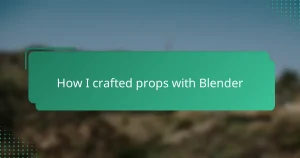Key takeaways
- Science fiction props serve as both functional story elements and artistic creations, requiring a blend of imagination and plausible science for effective 3D printing.
- Optimizing models for 3D printing involves strategic considerations like model orientation, material selection, and structural adjustments to enhance durability and print quality.
- Utilizing mesh repair tools and decimation techniques is essential for preventing print failures and ensuring models are both detailed and print-friendly.
- Finishing techniques such as sanding, priming, and applying clear coats significantly enhance the visual quality of printed props, making them appear more realistic and polished.

Understanding science fiction props
Science fiction props are more than just objects; they are gateways to entire worlds and stories. When I first started working with these props, I was amazed by how every design choice, from sleek metallic finishes to intricate circuitry, conveys a narrative or hints at advanced technologies. Don’t you find it fascinating how a well-crafted prop can evoke the feeling of stepping into a future yet to come?
In my experience, understanding these props means appreciating their dual role as both functional elements in a story and pieces of art. Each one carries a carefully considered blend of imagination and plausible science, which makes them challenging yet rewarding to recreate. It’s this balance that drives me to refine every detail when preparing models for 3D printing.
Sometimes, I wonder what the creator envisioned when designing a specific prop—was it meant to inspire awe, fear, or curiosity? Thinking about this helps me capture not just the shape but the essence, ensuring the final printed piece feels authentic and alive. This emotional connection is what makes working on science fiction props so incredibly fulfilling.
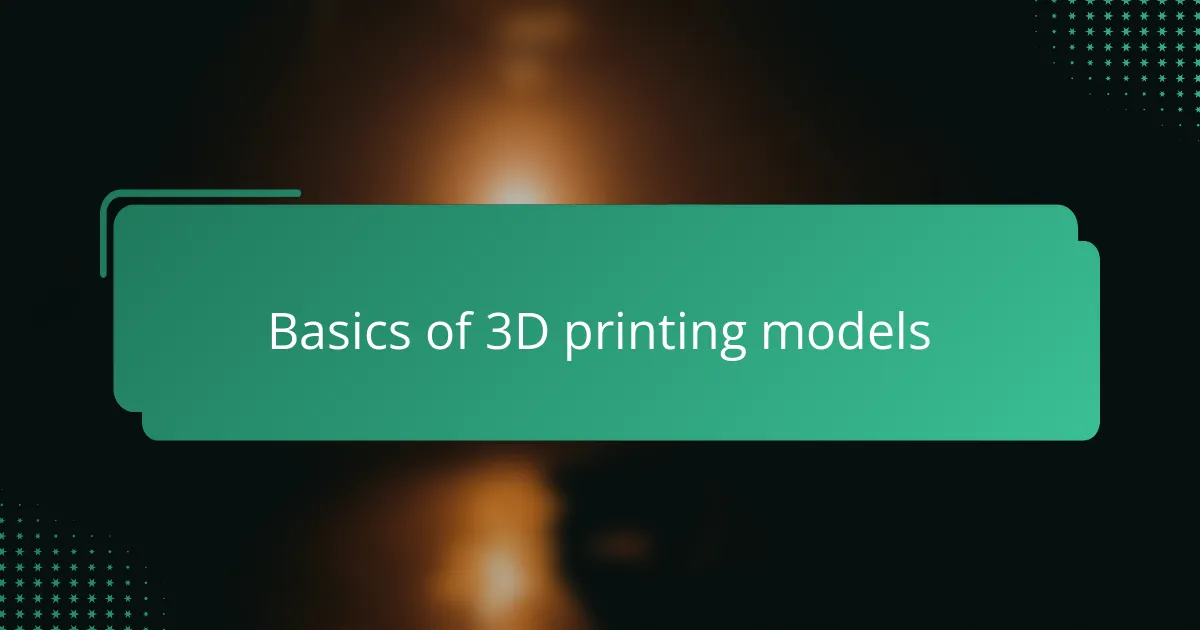
Basics of 3D printing models
When I began optimizing models for 3D printing, the first thing I had to grasp was the importance of designing with printability in mind. Have you ever tried to print a model only to have it fail because of overhangs that were too steep or walls that were too thin? I quickly learned that understanding the printer’s limitations—like minimum wall thickness and support requirements—was essential to avoid these common pitfalls.
One particular moment stands out when I was working on a complex rifle prop. I initially ignored the need for proper model orientation, and the print came out with layers misaligned and delicate parts broken. That experience taught me to think critically about how the model’s geometry interacts with the printing process, ensuring supports are minimized and details are preserved. Optimizing early means fewer surprises later.
What really fascinates me is how subtle changes in the model’s structure can drastically affect print success. For example, adding chamfers to sharp edges or slightly thickening tiny features can make the difference between a fragile print and a sturdy prop ready for painting. It feels like I’m fine-tuning not just a piece of plastic, but the soul of the prop itself. Have you noticed how small tweaks can transform a print’s outcome? That’s the essence of 3D printing optimization in my work.

Key optimization techniques for printing
One key technique I rely on is adjusting the model’s orientation before printing. It might seem trivial at first, but changing the angle can reduce the need for excessive supports and improve surface quality where it matters most. Have you ever seen a prop with ugly support scars? I’ve learned to position models so those marks end up in less visible areas, preserving that sleek, futuristic look.
Another trick that has saved me more times than I can count is hollowing out bulky sections. It not only cuts down on printing time and material but also prevents issues like warping or internal stresses. At one point, I printed a hefty helmet prop solid, and it came out heavier and cracked in a few spots. Making it hollow was a game-changer—lighter, stronger, and more printer-friendly without sacrificing detail.
Lastly, I pay close attention to adding subtle reinforcements to delicate parts. Thin antennae or tiny buttons look amazing but can snap easily if printed as-is. By slightly thickening these elements or adding internal ribs, I keep the prop’s aesthetic intact while boosting its durability. Isn’t it fascinating how such small adjustments can elevate a print from fragile to lasting? This balance between precision and practicality keeps me coming back to the modeling software with fresh ideas.
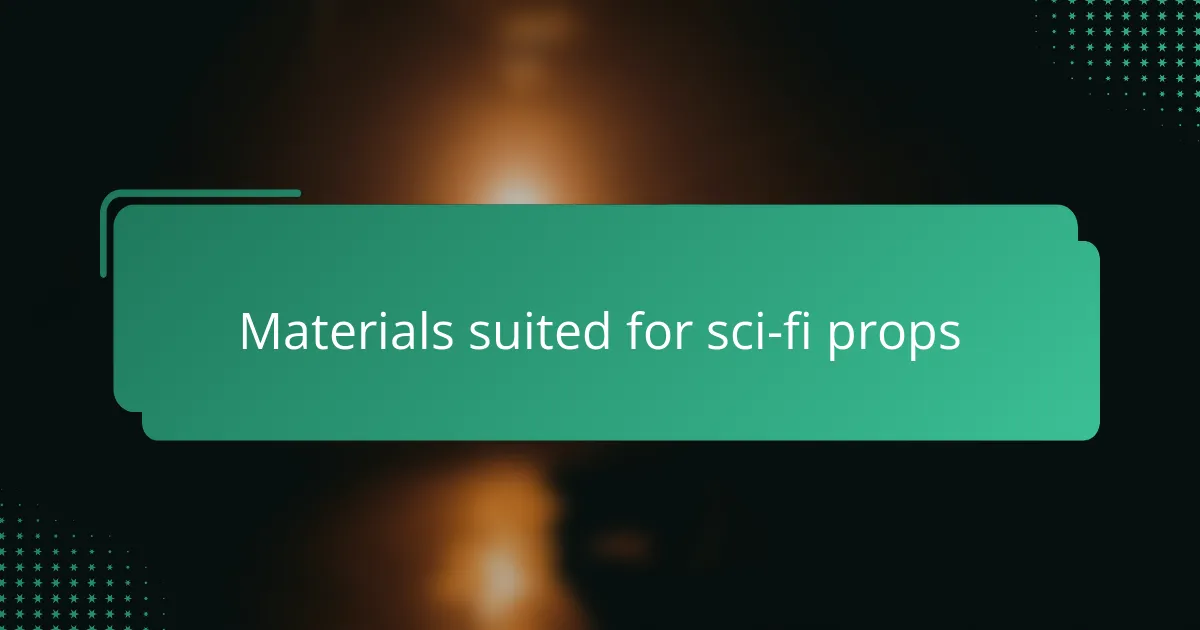
Materials suited for sci-fi props
When selecting materials for sci-fi props, I’ve found that PLA often strikes the perfect balance between ease of printing and detail retention. Have you ever been frustrated by a material that just wouldn’t hold the fine lines of a futuristic panel or control interface? PLA’s smooth finish and minimal warping make those intricate designs come to life without turning the process into a battle.
That said, if durability and heat resistance are priorities—say, for a wearable armor piece—I lean toward ABS or PETG. I remember printing a complex helmet that needed to survive convention wear and tear; switching to PETG made all the difference, offering flexibility without sacrificing strength. These materials can be a bit trickier to print, but the payoff in toughness is worth the extra effort.
For props needing a metallic sheen or a bit of heft, resin printing with specialty resins has become my go-to. The crisp detail and ability to capture nuanced textures elevate a prop’s realism instantly. Have you seen those sci-fi gadgets with flawless, mirror-like surfaces? Resin lets me achieve that effect, making each piece feel like it was torn straight from a futuristic flick rather than the build plate of my printer.
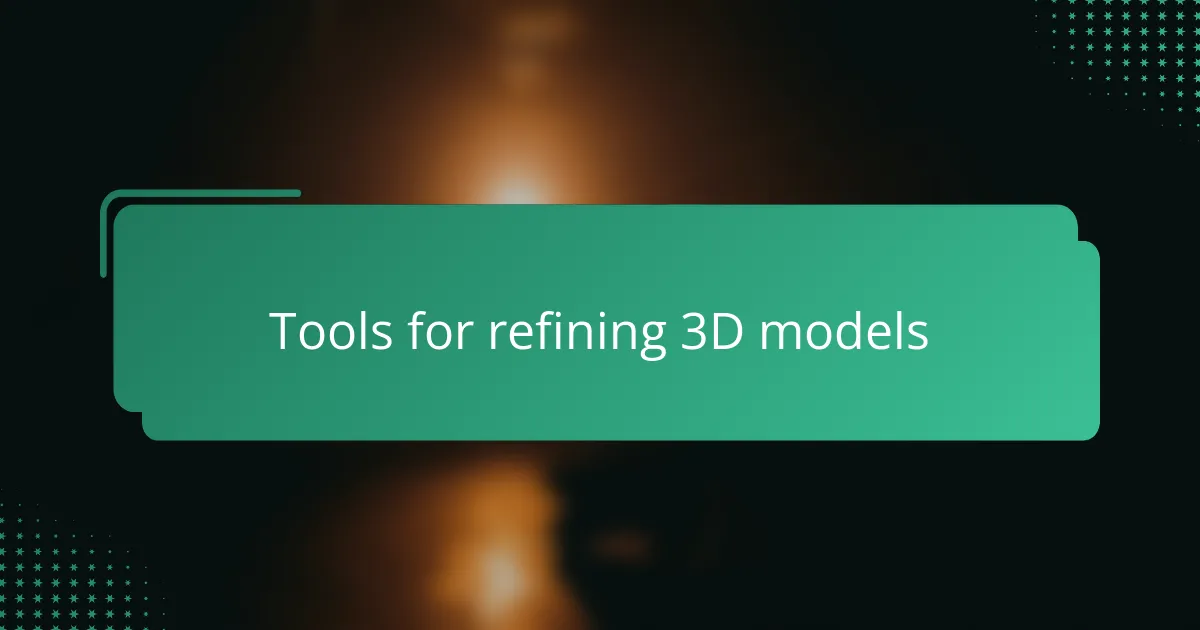
Tools for refining 3D models
When I refine 3D models, I always start with mesh repair tools like Meshmixer or Netfabb. They catch tiny holes or non-manifold edges that I might have missed, preventing print failures that once wasted hours of my time. Have you ever spent days printing only to realize a hidden mesh error ruined the entire piece? These tools save me from that frustration every time.
I also rely heavily on sculpting and smoothing features in software like Blender. When a sci-fi prop demands sleek curves or worn mechanical details, subtle tweaks can bring the model to life. From my experience, even small adjustments in surface texture make a tremendous difference in how the final print reads under paint and lighting.
Don’t underestimate the power of decimation tools as well. I remember working on a dense spaceship model that initially choked my printer due to excessive polygons. Reducing the polygon count without losing detail helped me strike a balance between complexity and printability. Have you noticed how a lighter, cleaner model often leads to fewer surprises during printing? That’s exactly the kind of control I look for during refinement.

Personal workflow for model optimization
When it comes to my personal workflow for optimizing models, I usually start by breaking down the prop into manageable parts. Have you ever tried printing a complex weapon or helmet as one piece only to have it fail halfway through? Splitting the model not only makes printing more reliable but also allows me to focus on detail in critical areas without compromising strength.
Next, I dive into checking every tiny filament thickness and overhang angle. It’s almost meditative—like tuning a musical instrument to hit every perfect note. Once, I spent hours tweaking a small antenna on a communicator prop, thickening it just enough to survive printing without losing its delicate look. Moments like that remind me why patience matters in this craft.
Finally, I always do a test slice and virtual inspection before sending the model to print. This step can save me from frustrating errors and wasted materials. Have you noticed how the software’s layer preview can reveal hidden troubles? Trust me, catching those early saves not only time and money but also keeps the thrill of creating alive.
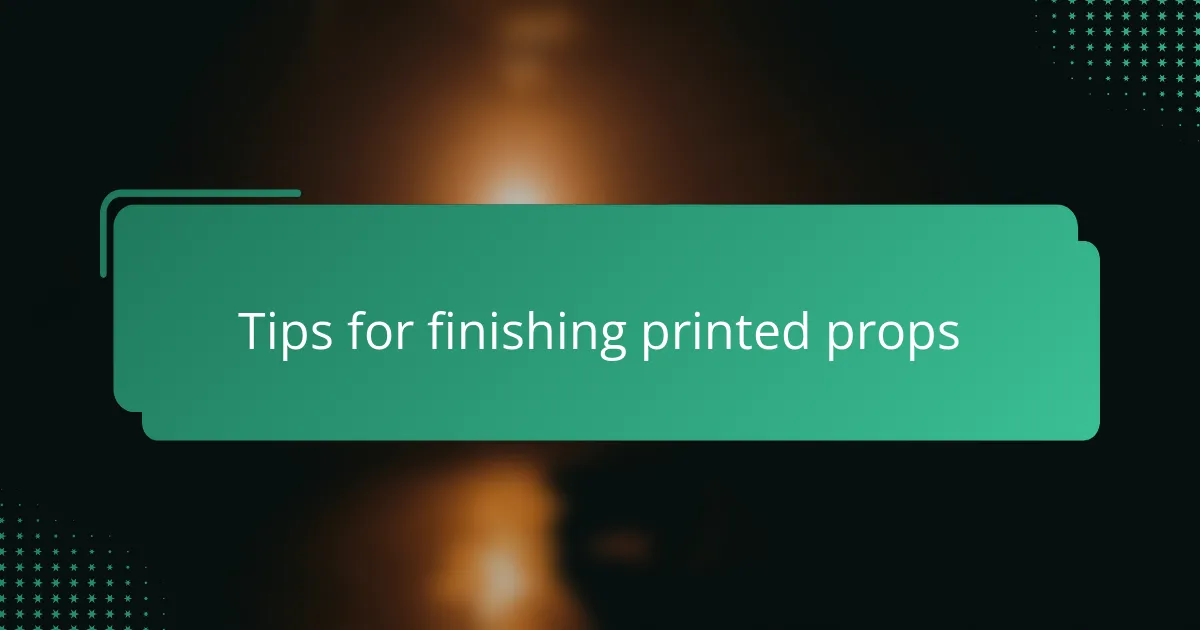
Tips for finishing printed props
Finishing printed sci-fi props is where the magic really starts to shine, at least in my experience. Have you ever held a freshly printed piece and felt that it still looks a bit raw, almost like it’s whispering, “I’m unfinished”? That’s exactly why sanding is my go-to first step—it smooths those layer lines and preps the surface for painting, turning rough plastic into something that feels believable and tactile.
I’ve also found that applying fillers or primers before painting can be a game-changer. Early on, I painted a prop without priming first, only to see tiny imperfections glaring back at me under convention lighting. Since then, I never skip a primer coat; it levels the surface and helps the paint stick better, making details pop and colors richer. Have you tried wet sanding between primer layers? It’s tedious but worth the payoff in that flawless finish.
Sometimes, I use a light clear coat after painting to protect the work and add a subtle sheen that suits the sci-fi aesthetic—matte for stealth gear or glossy for sleek gadgets. In one project, adding a gloss coat transformed a dull communicator prop into a piece that looked right off a spaceship set. Finishing touches like weathering or dry brushing then breathe life into the prop, giving it a story beyond the print. Don’t you love how these small details can make a big impact?

